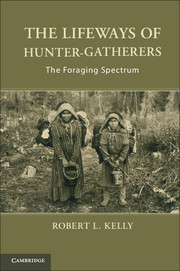Book contents
- Frontmatter
- Contents
- Tables
- Figures
- Preface
- Acknowledgments
- One Hunter-Gatherers and Anthropology
- Two Environment, Evolution, and Anthropological Theory
- Three Foraging and Subsistence
- Four Mobility
- Five Technology
- Six Sharing, Exchange, and Land Tenure
- Seven Group Size and Demography
- Eight Men, Women, and Foraging
- Nine Nonegalitarian Hunter-Gatherers
- Ten Hunter-Gatherers and Prehistory
- Notes
- References
- Index
Three - Foraging and Subsistence
Published online by Cambridge University Press: 05 April 2013
- Frontmatter
- Contents
- Tables
- Figures
- Preface
- Acknowledgments
- One Hunter-Gatherers and Anthropology
- Two Environment, Evolution, and Anthropological Theory
- Three Foraging and Subsistence
- Four Mobility
- Five Technology
- Six Sharing, Exchange, and Land Tenure
- Seven Group Size and Demography
- Eight Men, Women, and Foraging
- Nine Nonegalitarian Hunter-Gatherers
- Ten Hunter-Gatherers and Prehistory
- Notes
- References
- Index
Summary
I would like to say a few words about this land. The only food I like is meat.
Inuk man (Brody 1987: 62)Why should we plant, when there are so many mongongos [nuts] in the world?
/Xashe, a Ju/’hoan man (Lee 1979)Subsistence studies have long been prominent in the anthropology of hunter-gatherers – and why not: without food, people die. Before Man the Hunter, anthropologists assumed that foragers mostly ate meat. And so it is ironic that one of the conference's revelations was the importance of plant food to hunter-gatherers. Especially persuasive were Richard Lee's data on Ju/’hoan diet, 85 percent of which was plant food. And Lee argued that the Ju/’hoansi were not alone: analyzing a sample of foraging societies, he found that the mean contribution of meat to foraging diets at all latitudes is only 35 percent. This helped overturn the patrilineal-band model, with its emphasis on the male hunting of large game. In fact, some even replaced the term “hunter-gatherer” with “gatherer-hunter” (e.g., Bender and Morris 1988)!
Recognition of the role of plant food in hunter-gatherer subsistence was an important step since it exposed bias in hunting-focused models of human evolution. Nonetheless, switching the emphasis from hunting to gathering repeats the error of stereotyping and deflects attention from understanding variability among forager diets. In this chapter, we first establish that hunter-gatherer diets are systematically related to their environments by demonstrating simple correlations between gross dietary and environmental variables. We then examine optimization models that anthropologists use to account for the composition of foraging diets.
- Type
- Chapter
- Information
- The Lifeways of Hunter-GatherersThe Foraging Spectrum, pp. 40 - 76Publisher: Cambridge University PressPrint publication year: 2013
- 1
- Cited by

